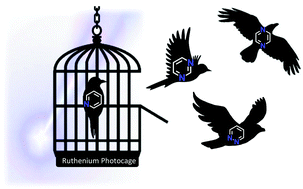Ru(ii) complexes with diazine ligands: electronic modulation of the coordinating group is key to the design of “dual action” photoactivated agents†
Abstract
Coordination complexes can be used to photocage biologically active ligands, providing control over the location, time, and dose of a delivered drug. Dual action agents can be created if both the ligand released and the ligand-deficient metal center effect biological processes. Ruthenium(II) complexes coordinated to pyridyl ligands generally are only capable of releasing one ligand in H2O, wasting equivalents of drug molecules, and producing a Ru(II) center that is not cytotoxic. In contrast, Ru(II) polypyridyl complexes containing diazine ligands eject both monodentate ligands, with the quantum yield (ϕPS) of the second phase varying as a function of ligand pKa and the pH of the medium. This effect is general, as it is effective with different Ru(II) structures, and demonstrates that diazine-based drugs are the preferred choice for the development of light-activated dual action Ru(II) agents.



 Please wait while we load your content...
Please wait while we load your content...